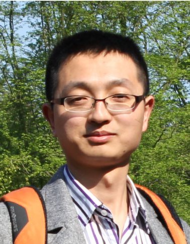“Chameleon” Macromolecules: Synthesis, Structures and Applications of Stimulus Responsive Polymers
Promotion date: 29. June 2012
Promotor: Prof. dr. ir. Julius Vancso
Assistant promotor: Dr. Mark Hempenius
| Stimuli-responsive polymers can dynamically alter their structures and properties like shape, surface characteristics, color, solubility or sol-to-gel transition on demand or in response to changes in their environment. Stimuli responsive polymer materials have been widely applied to prepare sensors, to regulate cell culture, to control wetting and adhesion, and in many other areas. The research is centered around preparing responsive polymer materials as building blocks for addressable structures, their characterization, and their applications. Polymer chains are assembled into various functional architectures such as polymer grafts on surfaces and polymer networks in bulk. Such addressable polymer architectures were constructed from temperature and cononsolvency responsive poly(N-isopropylacrylamide) (PNIPAM), pH responsive poly(methacrylic acid) (PMAA) and redox responsive poly(ferrocenylsilane) (PFS) chains. |
Was your project fundamental in nature, or also application oriented?
In the first place the work was fundamental. On the other hand a wide range of applications are thinkable. In this thesis we did some proofs of principle.
First I concentrated on functional polymers on surfaces. Later on we had polymer networks, macroscopic hydrogels and microgels/nanogels under investigation. Some of them like PNIPAM grafts are usable for cell culture purposes. Cells can bind to these polymer grafts, depending on the surrounding temperature or, on the contrary, free themselves from the surfaces. In others, like PFS hydrogel’s, colour shifts can arise using electrical currents which can be used as sensors.
Collaborating with professor Albert van den Berg’s group even led to possible lab-on-a-chip integration. The PFS nanogels/microgels produced here, show redox responsive properties and promising applications in catalysis and molecular release.
In what way did you develop as a researcher and scientist?
In China I was a polymer chemist. Most of the work was the synthesis of different polymers in solution. Here, at Mesa+, I learned to take binding macromolecules to surfaces into account and to incorporate crosslinking networks.
I also collaborated intensely with experts from physical and biomedical areas, for example dr. Stefan Kooij. His in situ ellipsometric approach was applicable in an important way to polymer grafts research. Also in our group, close collaborating with atomic force microscopy experts opened new areas of interest and skills for me.
Did you manage to get some nice publications?
I had publications, like in: Journal of the American Chemical Society, Small, Journal of Materials Chemistry and Polymer Chemistry.
Furthermore, the PFS microgel work, will be taken into successive research at Mesa+, subsidizing one or two PhD’s.
What are your future plans?
I am bringing my expertise on chemistry and surfaces into practice at AkzoNobel in Deventer now. This is one of the largest coating companies in the world. It is a great opportunity to find out if the commercial and marketing field of work is appealing to me, or not. Perhaps in the more far away future I return to academic research, or stay in commercial research in Holland, Europe or, preferably, China.
What in your opinion is important for Mesa+ to stay successful in future?
The Mesa+ Day was very important to me. Here some nice collaborations started which were very favourable for me and my research project. Also the group meetings were helpful for me.
Organising meetings involving top class scientists from all over the world is both inspiring and opening ways to attract new talent to come to the University of Twente.
The top facilities in the new building provide excellent chances, especially for young PhD’s.
Showing what Mesa+ stands for on the big screens present in the building itself, would be a nice idea, I believe. In this way, one can learn the research taking place in the building, simply by waiting in the hallway or by going up and down in the elevator. Here news features and the upcoming of lectures can be shown as well.

